Huawei P30 Und P30 Pro Test
Please note: In September 2019, we updated the DXOMARK Mobile exam protocol to encompassultra-wide-angle performance and have renamed the protocolDXOMARK Photographic camera. We also expanded our depression-calorie-free testing and created the newNight sub-score, which incorporates the previous Flash score. Nosotros have retested this device using the new Wide and Night test protocols and updated this review. The updated elements and scores are right at the top; you can still find the original review further down the page. For more data, please encounter the manufactures nearly our new Broad and Dark test protocols.
The Huawei P30 Pro is the Chinese manufacturer's current flagship smartphone and comes with a triple-camera setup (quad-camera, if you count the fourth dimension-of-flight sensor) that offers a plethora of improvements over both previous Huawei loftier-end devices, the P20 Pro and the Mate 20 Pro.
The principal camera comes with a one/1.seven 40Mp quad sensor that produces 10Mp epitome output. The 27mm-equivalent lens comes with an f/one.6 discontinuity and is optically stabilized—a first for this sensor size in a smartphone. In that location are also a 20Mp super-wide-angle (16mm-equivalent) photographic camera and a stabilized tele-camera that uses folded eyes to achieve a 5x optical zoom factor (125mm equivalent).
Update summary

116

camera
With the inclusion of the new Wide and Night sub-scores, the Huawei P30 Pro Photo score increases from 119 to 125 points, which in turn boosts its overall DXOMARK Camera score from 112 to 116 points.
In wide-angle manner, the P30 Pro'due south maximum field of view is not quite as wide as the Samsung's, simply it is one of the all-time-performing devices we've tested at 16mm, thanks to consistently good results for all attributes. Images captured at the default wide-angle setting show excellent target exposures in portraits and broad dynamic range when shooting in vivid light. Color rendering is also very pleasant, with adept saturation in both indoor and outdoor shots and generally authentic white balance. The P30 Pro'southward performance drops noticeably even when slightly zooming in, however. At focal lengths between 18 and 21mm, we observed low target exposures, limited dynamic range, and desaturated color in all test conditions.
For our new Nighttime depression-light test protocol, the Huawei is currently 1 of the best performers. In wink automobile mode, the camera produces portrait shots with practiced exposure, color, and detail when the wink triggers. On the downside, flash activation tin be erratic, with the flash not triggering for backlit scenes, which can event in underexposed subjects and low dynamic range. Wink-off image results are amid the best we have seen, however, showing good exposure, broad dynamic range, and well-preserved details.

Wide
In wide-angle mode, the P30 Pro is i of the all-time-performing devices we've tested at 16mm, cheers to consistently proficient results beyond the board. 16mm outdoor shots are specially successful, boasting first-class target exposures in portraits and broad dynamic range when shooting in bright light. Color rendering is also very pleasant, with good saturation evident in both indoor and outdoor shots, and with generally accurate white rest that avoids any serious or offensive colour casts.

Huawei P30 Pro, 16mm, outdoor color
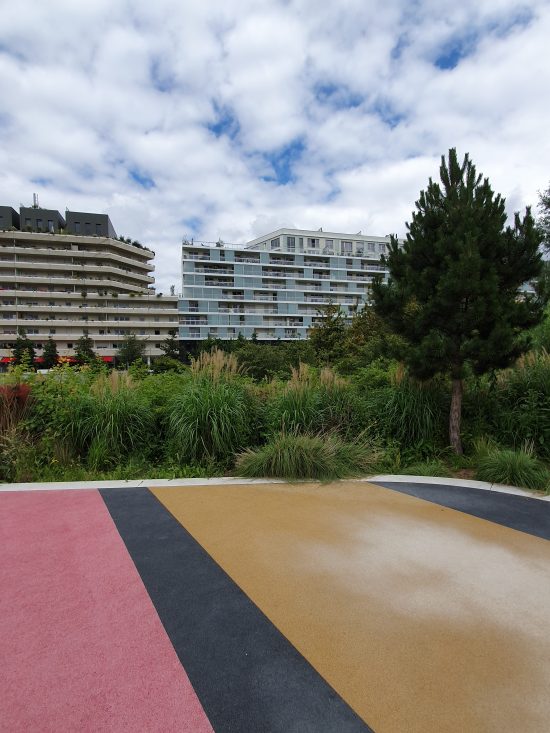
Samsung S10 5G, 16mm, outdoor color
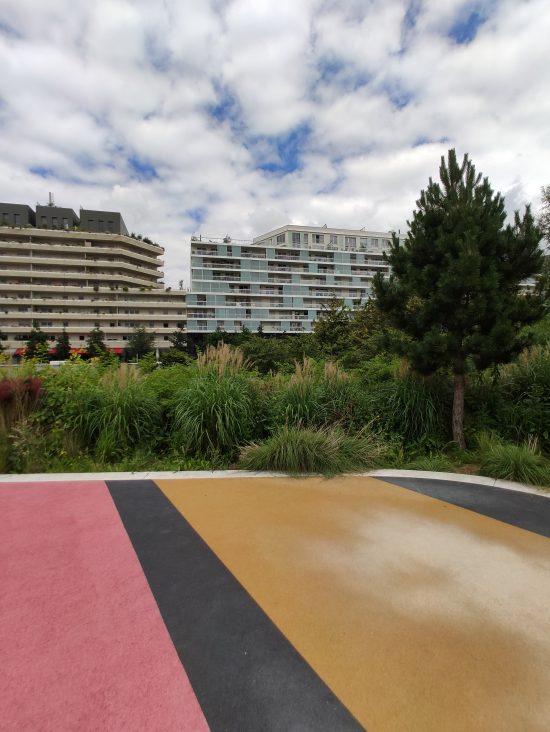
Xiaomi Mi ix, 16mm, outdoor colour
Artifacts are generally well-controlled at 16mm, as well, and although some color fringing and unnatural item rendering on faces is visible, the P30 Pro avoids any serious problems in outdoor shots. The unusual detail rendering gets noticeably worse in indoor shots, though, with over-sharpening on faces, as well as a loss of sharpness towards the edges of the frame, which impacted the P30 Pro'due south Broad score.
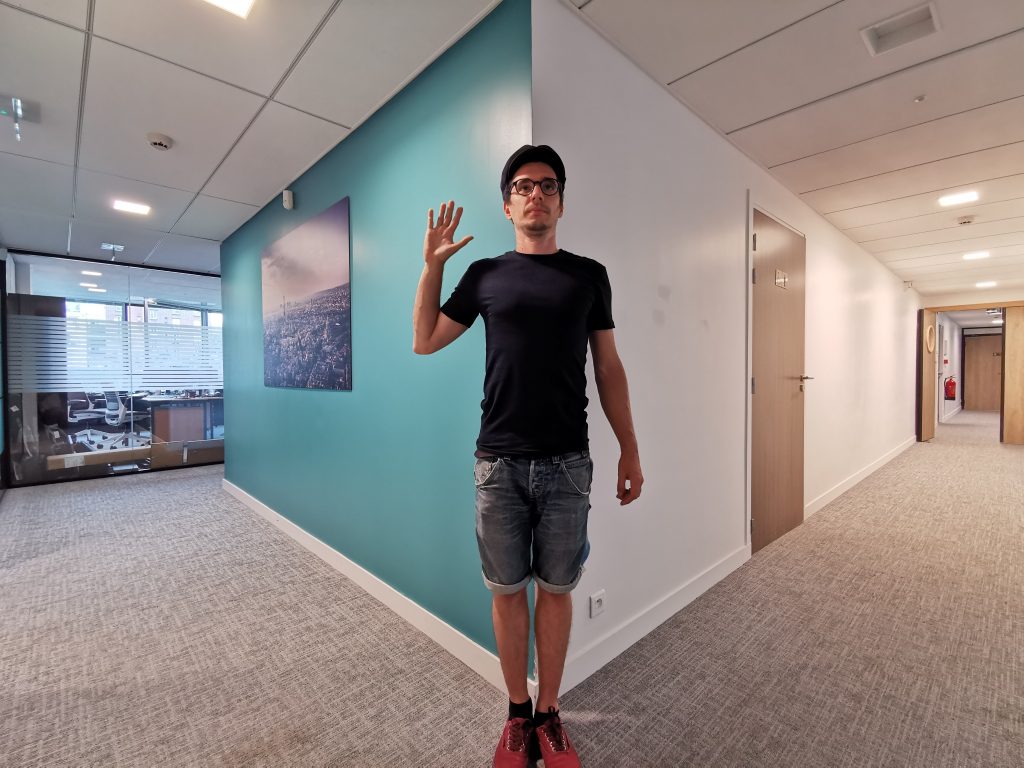
Huawei P30 Pro, unnatural face rendering

It'due south worth noting that the P30 Pro too performed noticeably worse in our tests using focal lengths between 18mm and 21mm. While exposure and color are by and large very good at 16mm, if you utilize a picayune compression zoom, image quality suffers from low target exposures, express dynamic range, and desaturated colour in both outdoor and indoor exposures.
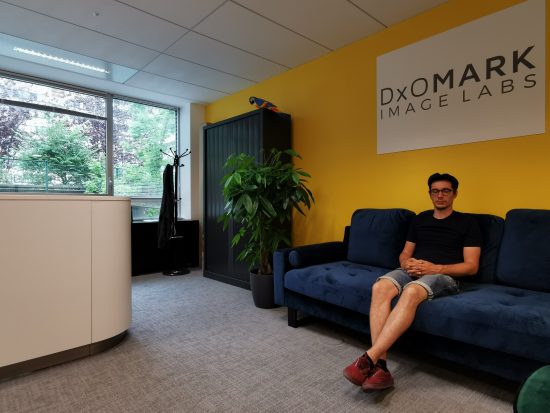
Huawei P30 Pro, 18mm, underexposure
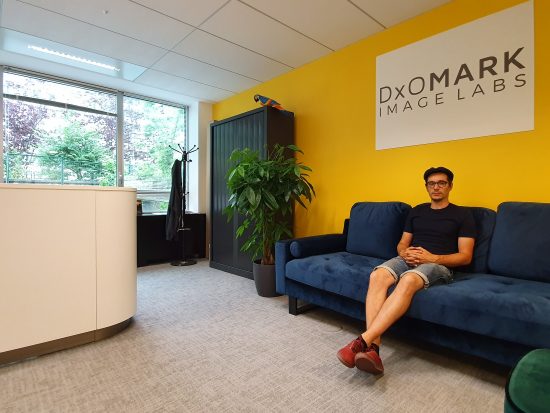
Samsung Galaxy S10 5G, 18mm, adept exposure
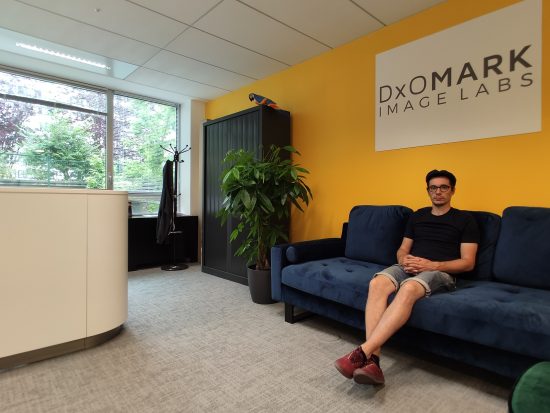
Xiaomi Mi 9, 18mm, slight underexposure
The P30 Pro besides dropped points in the Wide category due to its minimum focal length setting. With 16mm the widest angle-of-view available on the Huawei device, you lot can't clasp equally much into the frame compared to such devices as the Samsung Milky way S10 5G, which boasts an ultra-wide 12mm setting.
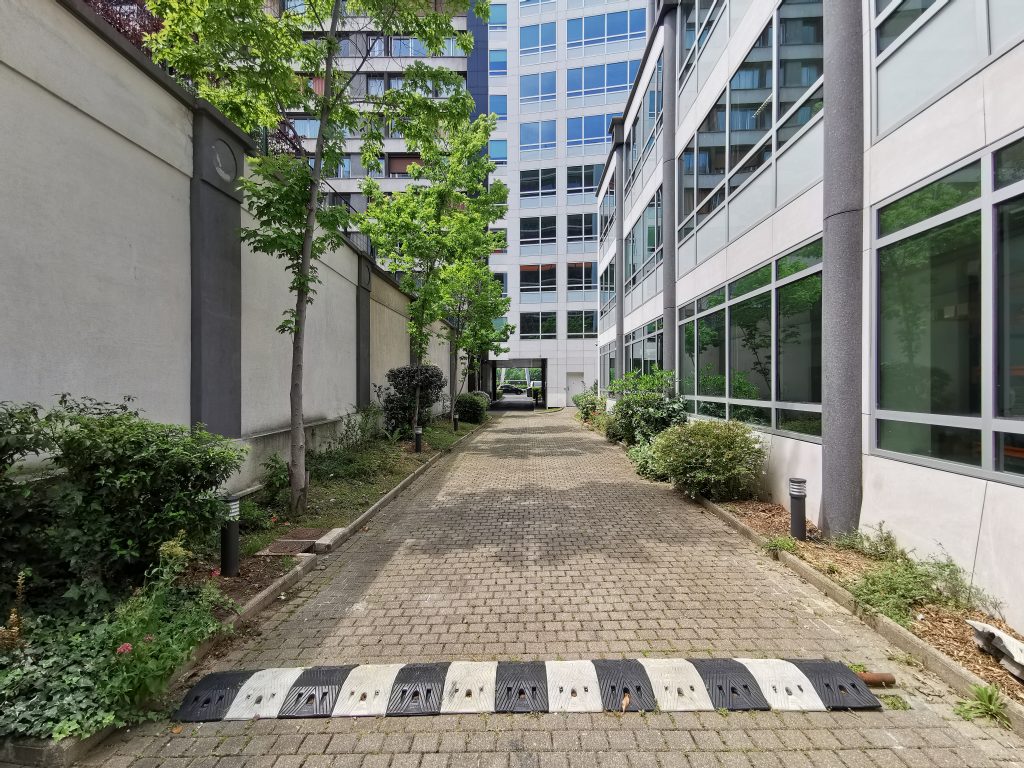
Huawei P30 Pro, 16mm minimum focal length
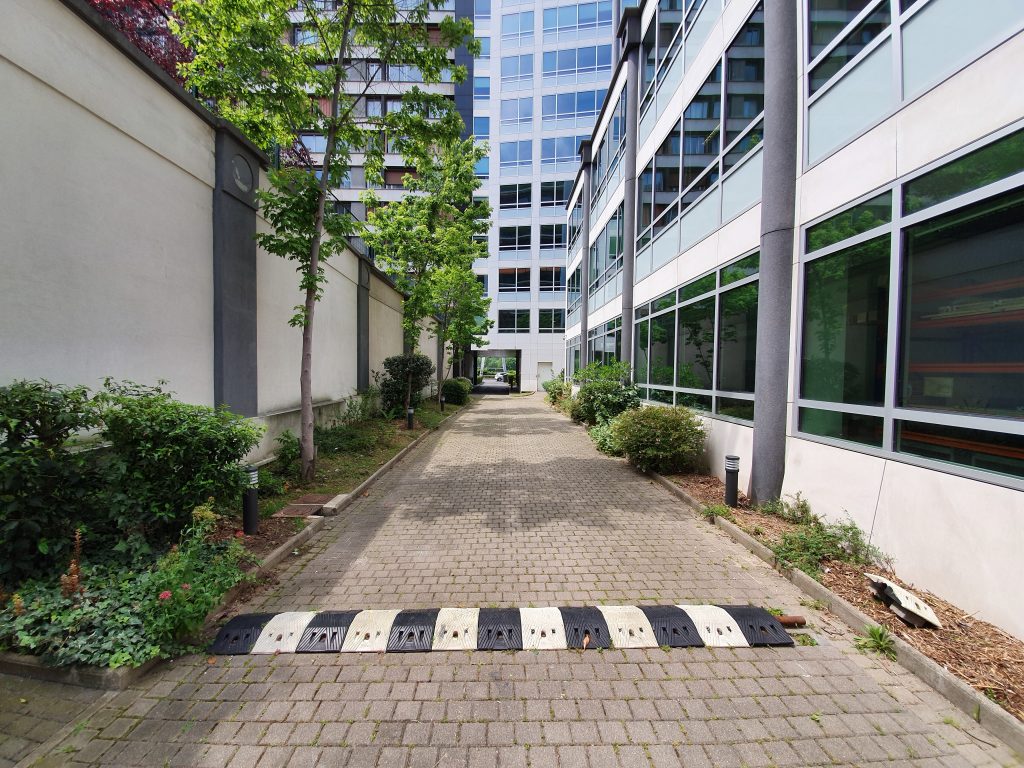
Samsung Galaxy S10 5G, 12mm minimum focal length

Night
With the flash off, the P30 Pro records some of the better-quality low-calorie-free cityscapes nosotros've captured. Overall exposure is proficient, with wide dynamic range ensuring that street and building lights aren't too overexposed, and skies or darker areas generally aren't noticeably underexposed. Details are also well-preserved, particularly in foreground; and although noise is visible and things start to get a bit smudgy in the background, texture and noise are the best we've seen in these atmospheric condition so far. Some colour and ringing artifacts go visible at close inspection, and colour rendering can be improved, with undersaturation and inaccurate white residuum occasionally axiomatic, but the P30 Pro achieves a pretty solid result overall.
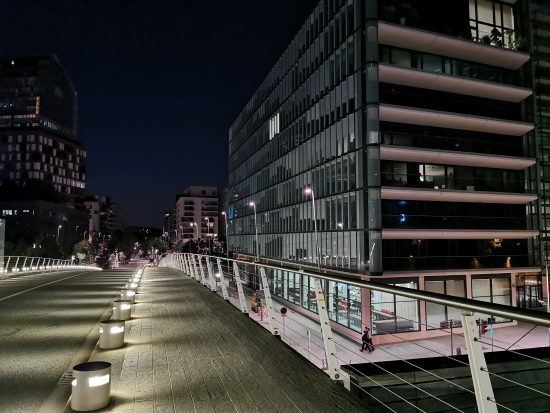
Huawei P30 Pro, flash off, cityscape

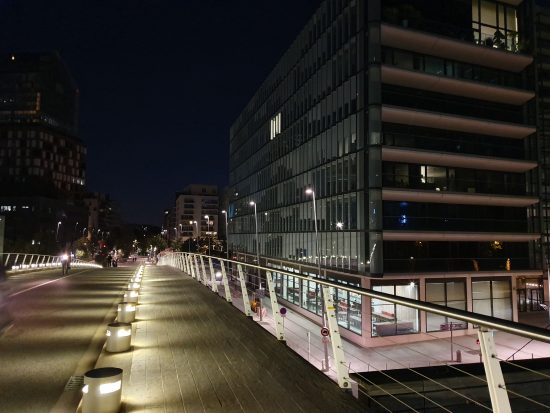
Samsung Galaxy S10 5G, flash off, cityscape

Samsung Galaxy S10 5G, crop
![]()
Google Pixel 3, flash off, cityscape
![]()
In flash auto mode, exposure, color and item are as well good in night portraits with the subject close to the camera, when the flash fires. Our testers found the P30 Pro'south default car-flash mode a little erratic, still, often non triggering for brilliant backlit portraits, resulting in an underexposed portrait and limited dynamic range. Flash occasionally fired unnecessarily in low-lite cityscapes, too, where it was ineffective in lighting the scene, and the overall result was pretty disappointing. So some fine-tuning is required to improve the P30 Pro's auto-flash functioning; and for now it'southward best to turn it off for depression-light cityscapes and to turn information technology on for portraits.

Huawei P30 Pro, flash auto, wink triggered, good exposure
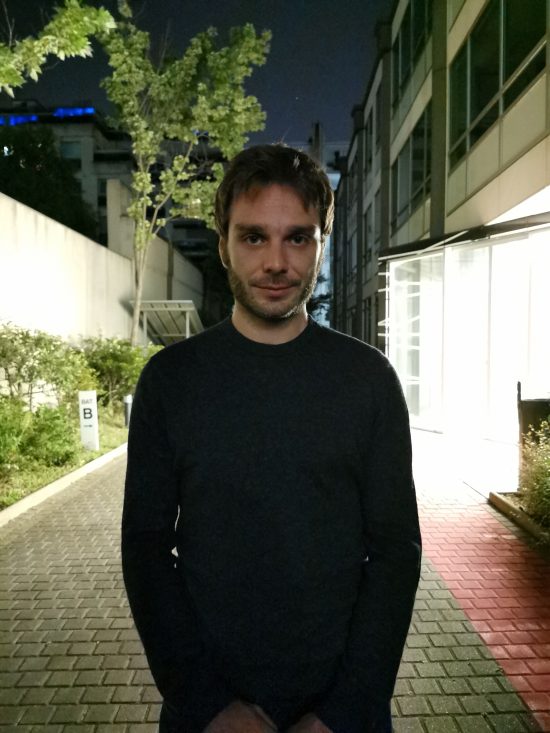
Huawei P30 Pro, wink auto, flash not triggered, underexposed bailiwick
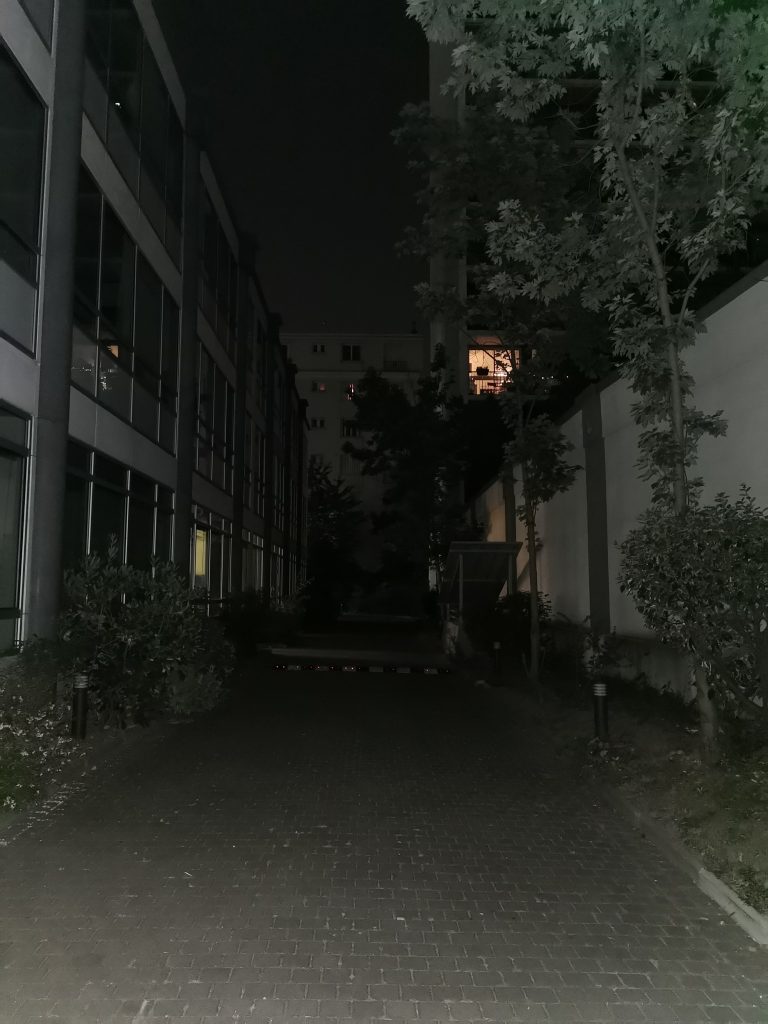
Huawei P30 Pro, flash automobile, flash triggered for mural scene
With the flash forced on, the P30 Pro performs very well. Images prove fairly good exposure, accurate white residue, good detail, and well-controlled noise levels. This is true for our test shots at both 0 and 5 lux illumination. Some slight color shading is visible in both situations, but the results are very consistent.
We had mixed success using the P30 Pro'due south dedicated Night Mode, which often produced a lower-quality shot compared to the flash off or the default auto-flash modes. In the best examples, such equally the 1 beneath, the Dark mode extends dynamic range for ameliorate results in particularly nighttime or challenging scenes, but we found color nether-saturated, white residual inaccurate, and texture low in many examples.
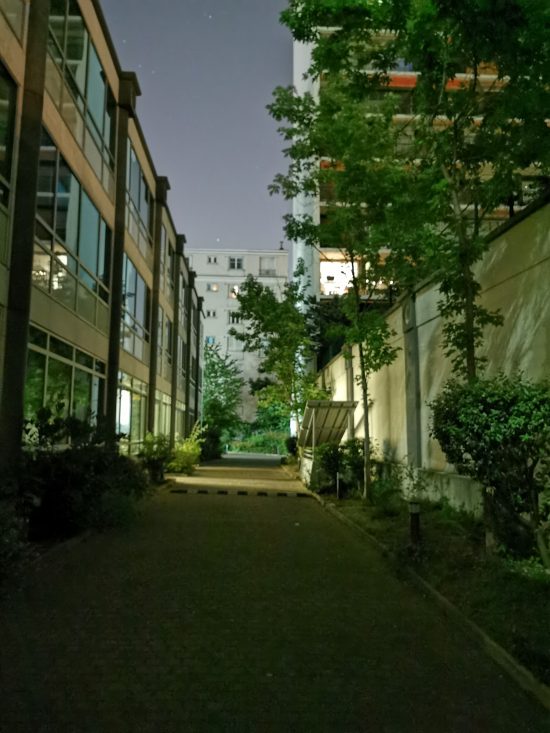
Huawei P30 Pro, Night manner, proficient exposure
![]()
Google Pixel 3, Night mode, underexposure
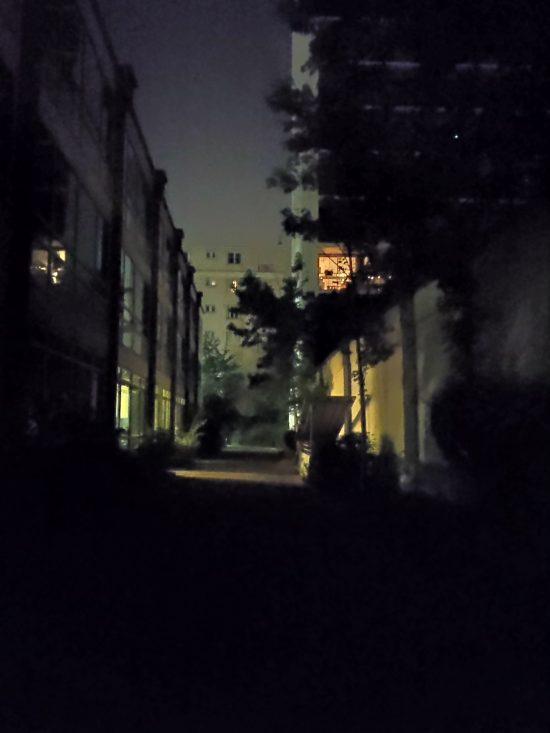
Xiaomi Mi 9, Night mode, underexposure
Huawei P30 Pro camera review (originally published March 26, 2019)
Launched near exactly one year afterward its predecessor, the P20 Pro, the Huawei P30 Pro is the Chinese manufacturer's brand-new flagship smartphone and comes with a triple-photographic camera setup (quad-camera, if you count the time-of-flight sensor) that offers a plethora of improvements over both the P20 Pro and the Mate 20 Pro (launched in October 2018).
The primary camera comes with a i/1.7 40Mp quad sensor that produces 10Mp image output. The 27mm-equivalent lens comes with an f/i.half-dozen discontinuity and is optically stabilized—a showtime for this sensor size in a smartphone. Thanks to a minimum focus distance of 25mm, the 20Mp super-wide-bending (16mm-equivalent) camera is capable of capturing macro shots, but the arguably virtually exciting innovation is the stabilized tele-camera that uses folded optics to reach a 5x optical zoom gene (125mm equivalent).
5x optical zoom with folded optics
The laws of physics make it hard to fit a longer zoom lens into a thin smartphone trunk. Fifty-fifty using smaller-than-usual prototype sensors and clever lens blueprint, manufacturers accept but managed and then far to accomplish two or 3x optical zoom factors in conventional high-end smartphones.
For the P30 Pro, Huawei uses folded optics to overcome this limitation. The prototype sensor is placed vertically within the telephone and aimed at a lens with an optical axis that runs along the body of the phone, and a mirror is used to reverberate incoming light into the lens and onto the sensor. This allows for a much longer equivalent focal length than would be possible with a camera oriented in the usual fashion—that is, one constrained past the phone'due south thickness.
"Field-of-view fusion" zoom
The P30 Pro doesn't rely just on hardware alone for zooming, all the same. Software is merely as important, and the P30 Pro uses a system Huawei calls field-of-view fusion, a combination of optical and algorithm-powered digital zooming that adapts to the chosen magnification factor. Upwards to 3x magnification, the tele-lens remains unused; instead, the camera performs all zooming with the help of a super-resolution algorithm—a concept similar to what nosotros saw on the Google Pixel iii, one in which the photographic camera merges several RAW frames into one high-resolution frame that it then crops for zooming.
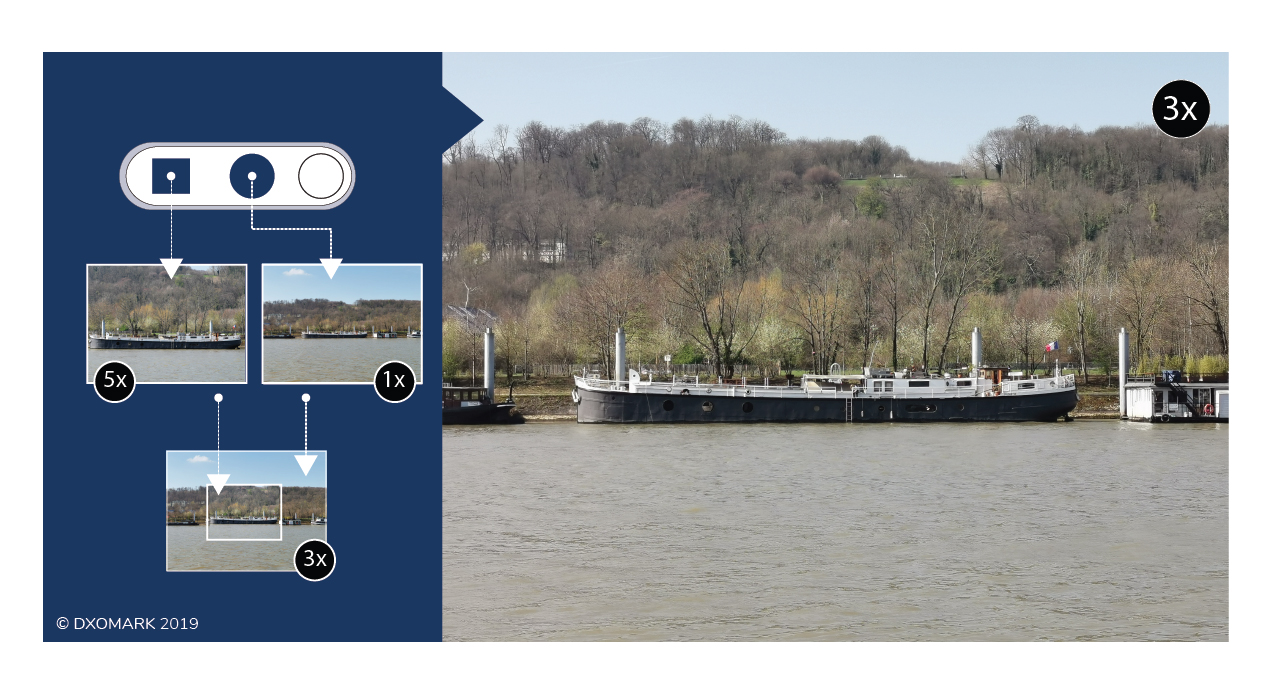
The primary camera is used for up to 2x zoom, and the tele-camera for 5x and longer. For intermediate zoom factors, the P30 Pro combines epitome data from both cameras.
At a 5x zoom cistron, the P30 Pro relies exclusively on the tele-camera, but for intermediate zoom factors between 3 and 5x, it captures image data using both the primary and tele cameras combined. For optimal particular, the 5x tele-cam records image information at the center of the frame, and the "missing" paradigm areas around the edges of the tele-cam frame are filled using AI-refined image data from the main camera. A deep learning algorithm improves detail on fine patterns and textures—quite an impressive feat, considering that autofocus, white remainder, and other image parameters of both cameras all have to be in perfect sync for good results.
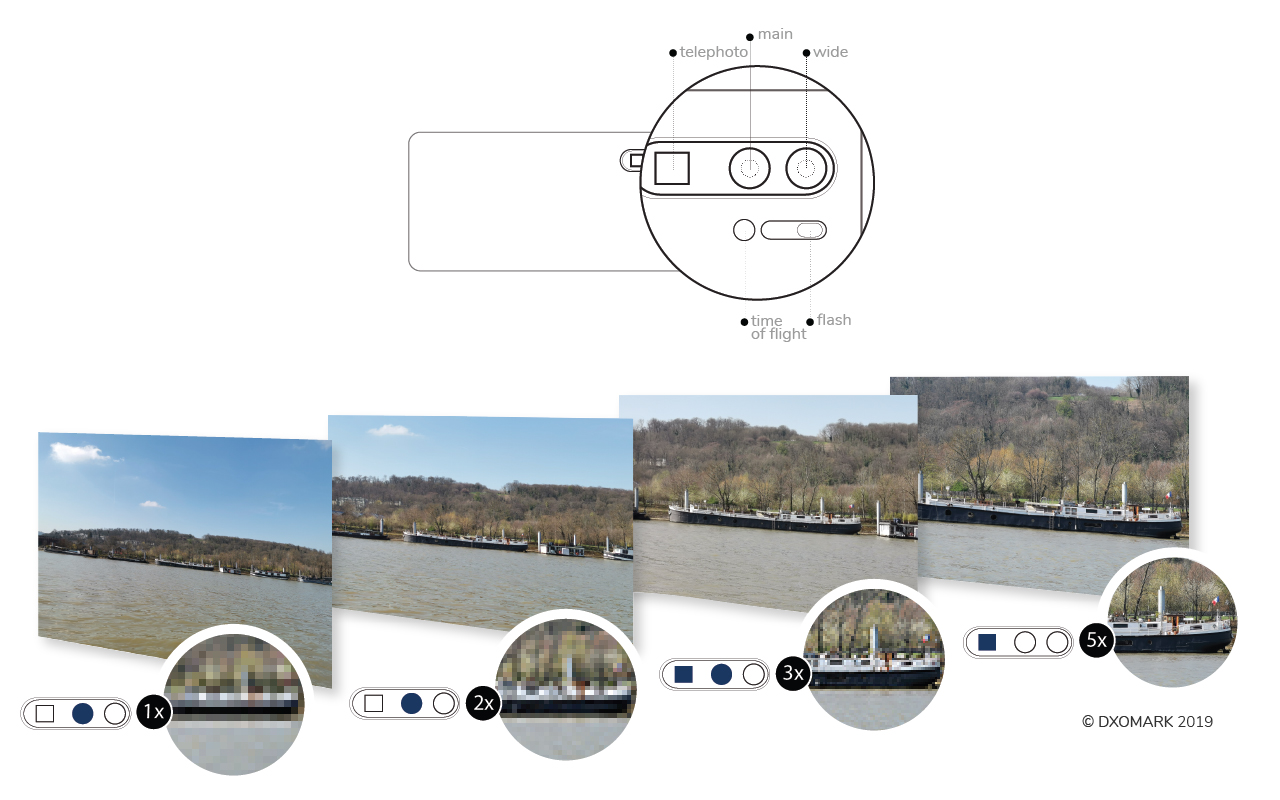
Camera usage for different zoom factors on the Huawei P30 Pro
At the long end, the camera is capable of achieving a 10x zoom factor using a combination of optical zoom and super-resolution processing that stacks multiple RAW frames on the tele-cam. (Users can even get upwardly to 50x with a digital zoom, but we did not test this characteristic.)
Upgraded bokeh mode with super-resolution
In addition to the all-new zoom organization, the P30 Pro features an upgraded bokeh mode. Super-resolution generates an image with 54mm equivalent focal length and good detail rendering. Information technology then uses information from the time-of-flight (ToF) light amplification by stimulated emission of radiation (which measures the distance to objects in the scene) to ostend and fine-melody the initial depth-map generated by the primary and super-wide cameras.
Adaptive frame rates in video mode
The P30 Pro uses H.264 encoding and records video at 60 frames per second in vivid light, capturing smoother footage of scenes in motility. In lower light, when slower shutter speeds are required for skillful exposure, the camera switches back to a more than conventional 30 frames per second. Unlike the Pixel 3, however, the Huawei does non record at intermediate frame rates, so information technology shoots at either 30 or 60 fps merely.
Looking at the impressive spec canvass and innovative photographic camera technologies, information technology could exist easy assume that the P30 Pro will accident the contest out of the water. But can its top-end hardware and innovative software really piece of work seamlessly together to create form-leading still and video prototype quality? Read our full test report to find out.
Key photographic camera specifications:
- Triple-camera setup
- Main: 40Mp, i/1.seven-inch quad RYYB sensor; f/ane.6-discontinuity lens, OIS, 27mm-equivalent focal length
- Tele: 8Mp sensor, folded optics with f/3.iv aperture lens, OIS, 125mm-equivalent focal length
- 20Mp super-broad-angle with f/2.2-aperture, 16mm-equivalent lens
- PDAF/Fourth dimension-of-flight (ToF) autofocus
- LED wink
Near DxOMark Mobile tests: For scoring and analysis in our smartphone camera reviews, DxOMark engineers capture and evaluate over 1500 test images and more than 2 hours of video both in controlled lab environments and in natural indoor and outdoor scenes, using the photographic camera's default settings. This article is designed to highlight the most important results of our testing. For more than information nigh the DxOMark Mobile examination protocol, click here. More details on how we score smartphone cameras are available here.
Examination summary
With a DxOMark Mobile score of 112, the Huawei P30 Pro is the new number one in our ranking and achieves this feat by building on an outstanding Photo score of 119 points. Compared to previous Huawei models such as the P20 Pro and the Mate twenty Pro, the most obvious improvements are in the areas of bokeh and zoom, where the P30 Pro sets new benchmarks, thanks to its innovative 5x tele-photographic camera with folded optics and ToF sensor that allows for more than precise depth maps in bokeh manner.

Outdoor images are well-exposed, with splendid detail and low noise.
That said, the P30 Pro performs well in most all our test categories. Exposure is expert down to extremely low light levels, and in challenging backlit situations, the camera is intelligent enough to focus prioritize subject exposure over the background. Dynamic range is not quite every bit wide as information technology was on the Mate xx, only it's nonetheless pretty practiced. Some clipping can occur in the highlights, but the images are a petty more than contrasty overall than with previous Huawei models.
The autofocus works flawlessly in all situations, and the Huawei engineers have once again found a very adept balance between item and noise. The P30 Pro renders fine details and textures better than well-nigh competitors beyond all lite levels, and at the same fourth dimension is capable of keeping racket levels low. This is also true for flash images, which are excellent overall, with practiced exposure, neutral white residue, and well-controlled light fall-off.
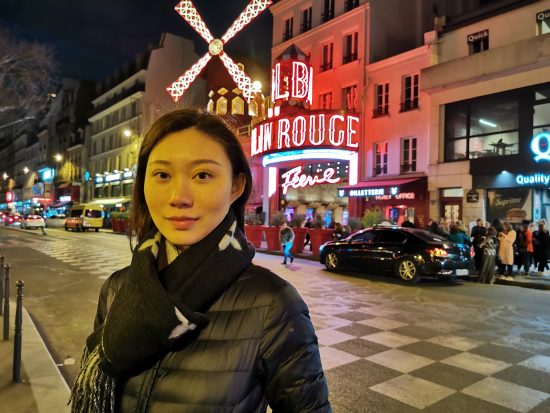
Low-light images show very good particular and noise, but we observed some colour casts.

The P30 Pro features an fantabulous bokeh mode.
The photographic camera's almost obvious weak points are color rendering and and artifacts. In terms of colour, our testers establish saturation to be slightly low across all light levels, and observed an unnatural cyan affect to bluish skies, along with other colour casts in bright light and in indoor images. Artifacts that nosotros found in our sample images include fairly intrusive hue shifts around clipped areas and a demosaicing antiquity effectually some light sources. More common artifacts such as ringing and moiré patterns are pretty well under control, though.
At 97 points, P30 Pro is not way ahead of the competition for Video like information technology is for Photo, but it'due south nevertheless among the all-time devices we have tested. Its epitome stabilization relies on both optical and electronic systems and is one of the best we accept seen, making for smooth footage in about situations. Every bit with still images, Huawei has found a good compromise betwixt texture rendition and noise reduction. Only in low light does some loss of detail and increased dissonance levels become more than obvious. The autofocus organisation works reliably in almost all situations as well. But as well like in stills mode, video footage is prone to color casts, and our testers also observed some white residual instabilities. Overall, notwithstanding, the P30 Pro is not only an outstanding smartphone for photo capture, it's besides a very solid choice for mobile videographers.
Photo scores explained
The Huawei P30 Pro'south Photo score of 119 is the best nosotros have seen then far and is partly due to outstanding results in the bokeh and zoom categories. The overall score is calculated from sub-scores in tests that examine different aspects of the camera'southward functioning nether different lighting atmospheric condition. In this section, nosotros'll have a closer look at these paradigm quality sub-scores.

Exposure and Contrast
The Huawei P30 Pro performs very well in this category, consistently producing adept target exposure and punchy contrast, even downwards to very low light levels. Fifty-fifty at near darkness—at a light level of 1 lux, where most competitors struggle—the P30 Pro camera is capable of capturing well-exposed images.
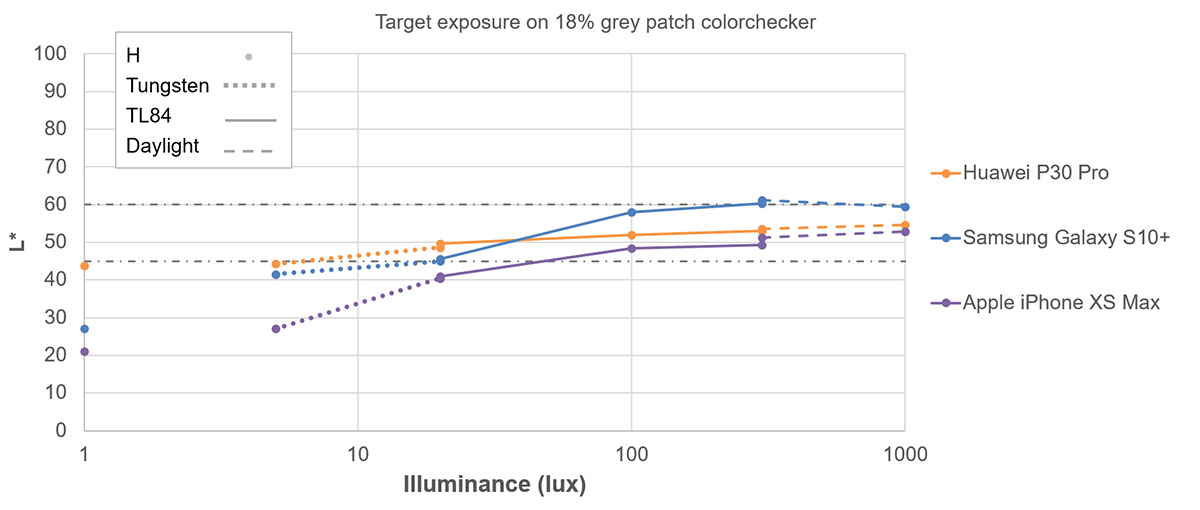
Huawei P30 Pro, target exposure assay


Apple iPhone XS Max, 1 lux

Samsung Galaxy S10+, 1 lux
The P30 Pro images also show practiced dynamic range, although it is not quite as wide as on the visitor'due south terminal high-end model, the Mate 20 Pro. P30 Pro images have slightly stronger contrast and a touch less detail in the shadows. We also observed some clipping in highlight areas of the frame in challenging high-dissimilarity scenes. So dynamic range is good overall, just not the best we take seen.

Huawei P30 Pro, high-contrast scene

Huawei Mate 20 Pro, high-dissimilarity scene
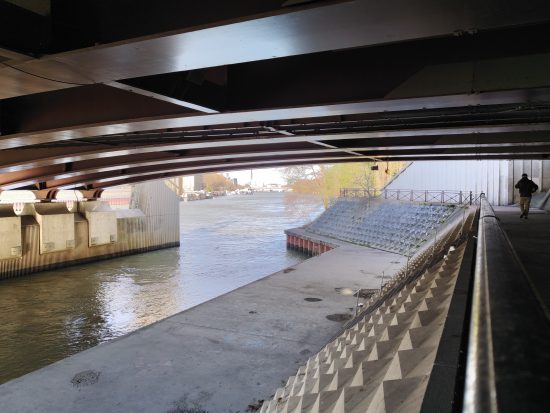
Xiaomi Mi 9, high-dissimilarity scene
The camera also deals well with backlit portrait scenes similar the 1 beneath. The exposure system prioritizes the subject'south face, ensuring good exposure of skin tones at the price of some clipping in bright backgrounds. For this kind of scene, this is a very sensible compromise.
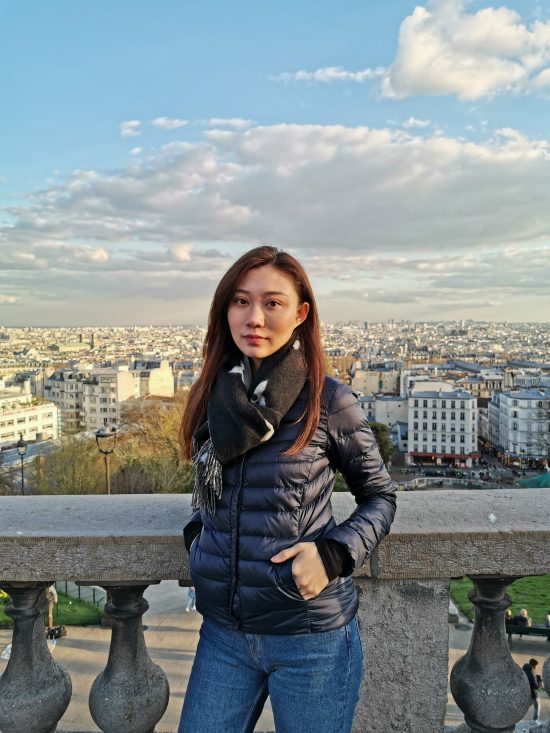
Huawei P30 Pro, backlit portrait
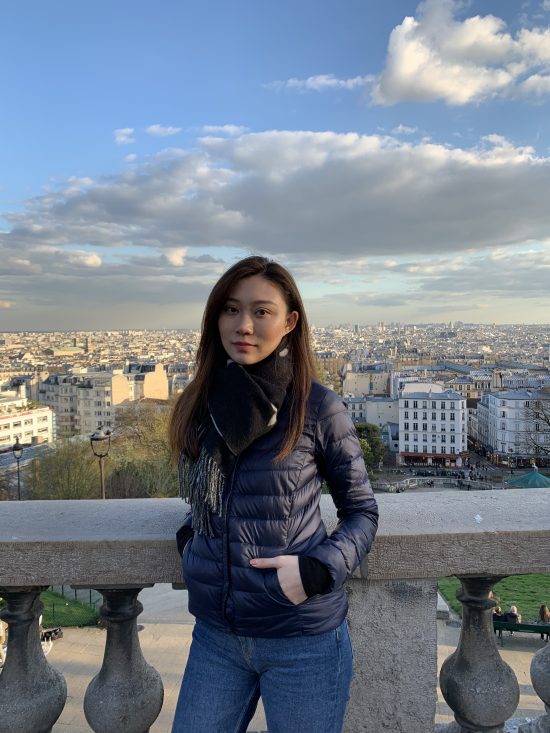
Apple iPhone XS Max, backlit portrait
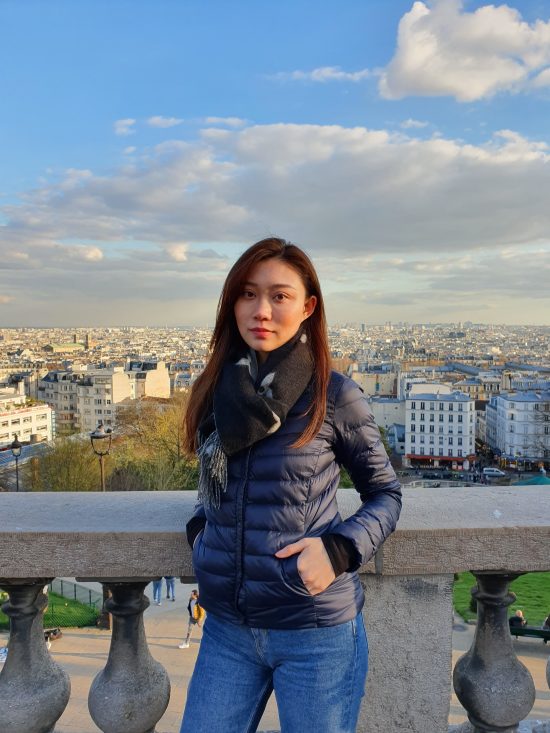
Samsung Milky way S10+, backlit portrait

Color
The P30 Pro scores well for Color, only our testers did identify a few areas for improvement, specially in bright light. When shooting outdoors in brilliant weather, saturation is a picayune low compared to competitors' generally more vivid images in similar conditions. We frequently found the color rendering of blue skies to exist a trivial unnatural also, with a noticeable cyan cast. On the plus side, white residue is neutral in both outdoor and indoor shooting conditions.

Huawei P30 Pro, outdoor color
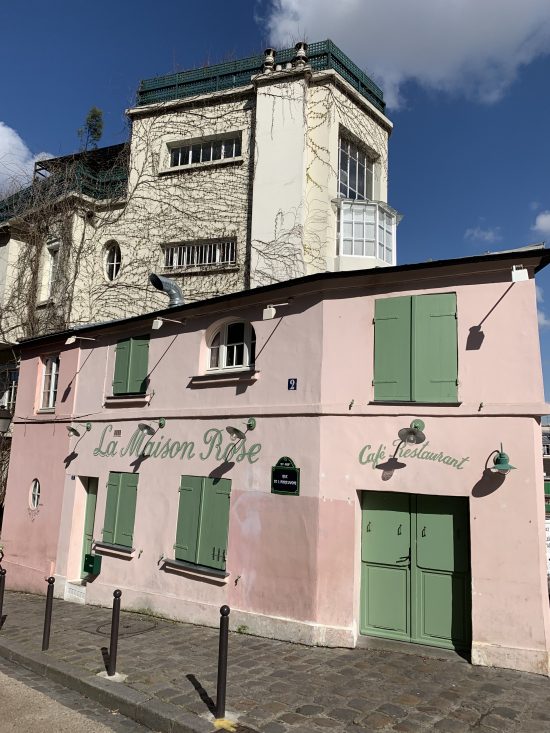
Apple iPhone XS Max, outdoor colour
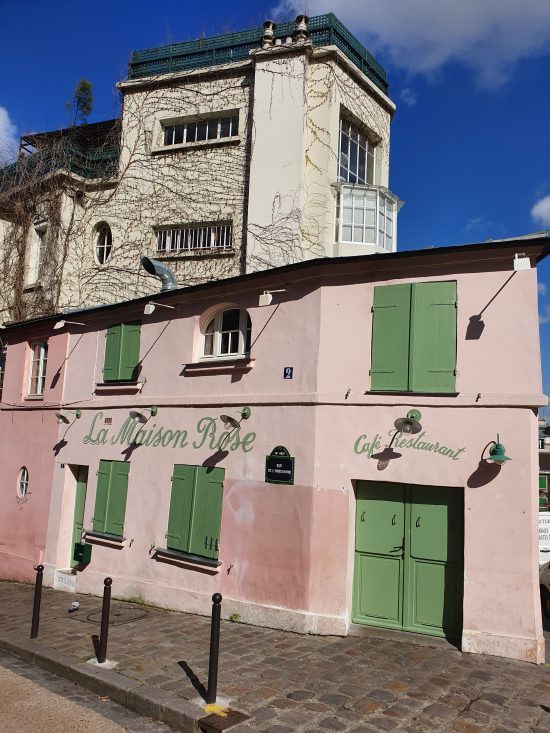
Samsung Milky way S10+, outdoor color
While the P30 Pro's color score in bright light is a little lower than for the best devices, color rendering under typical indoor lighting and in low light is pretty proficient—although we see slightly low saturation in those weather condition as well. In the indoor pic below, there'due south also a slightly pink cast, but there is no noticeable color shading, and overall, the P30 Pro'south color rendering handles indoor and depression-light situations very well.

Huawei P30 Pro, indoor color

Apple iPhone XS Max, indoor color

Samsung Milky way S10+, indoor color
The P30 Pro's PDAF autofocus organization is assisted by a ToF laser that tin can measure subject distance in any light condition. As a result, the Huawei AF focuses quickly and produces consistently sharp images in all light conditions. In the comparison graph below, you tin can see that the P30 Pro's AF is on the same loftier level every bit such other flagship smartphones as the Samsung Milky way S10+ and the iPhone XS Max. Thanks to zippo shutter lag and buffering technologies, the camera is capable of capturing an epitome near at the same time every bit the shutter is pressed, for both curt and long delays later on defocusing.
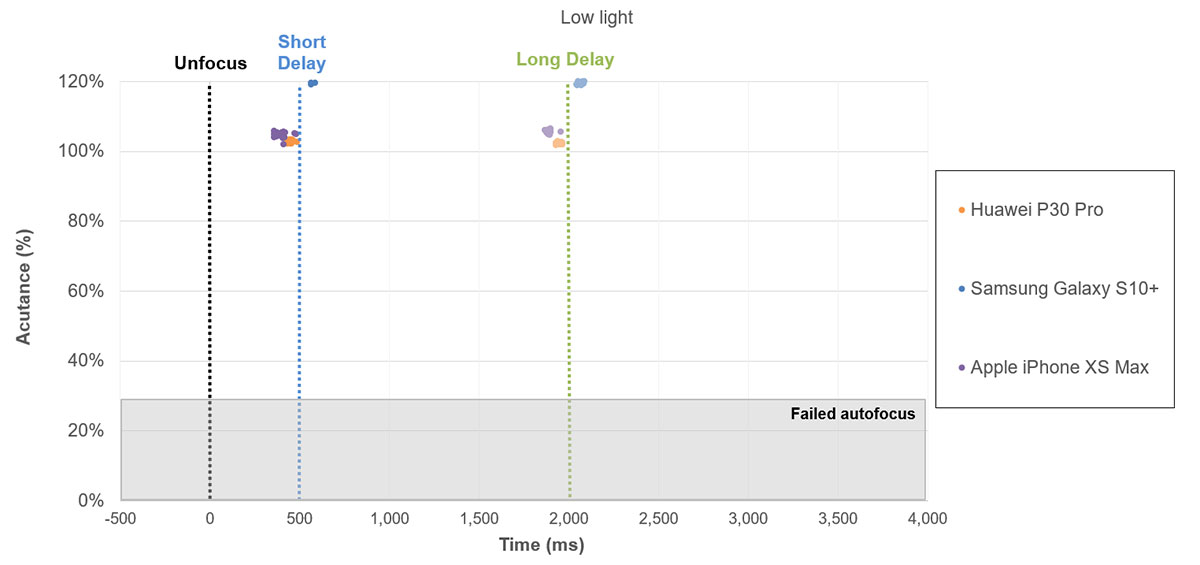
Autofocus performance comparing at twenty lux

Texture

Noise
The P30 Pro epitome processing finds a very good residuum between detail retention and racket reduction, and the Huawei is amongst the very best devices overall for texture and noise in all light conditions. In the vivid-calorie-free shot beneath, you tin see that the P30 Pro prototype shows noticeably better fine item and texture than the iPhone XS Max and the Samsung Galaxy S10+, while at the same fourth dimension keeping noise in the bluish sky very well nether control.
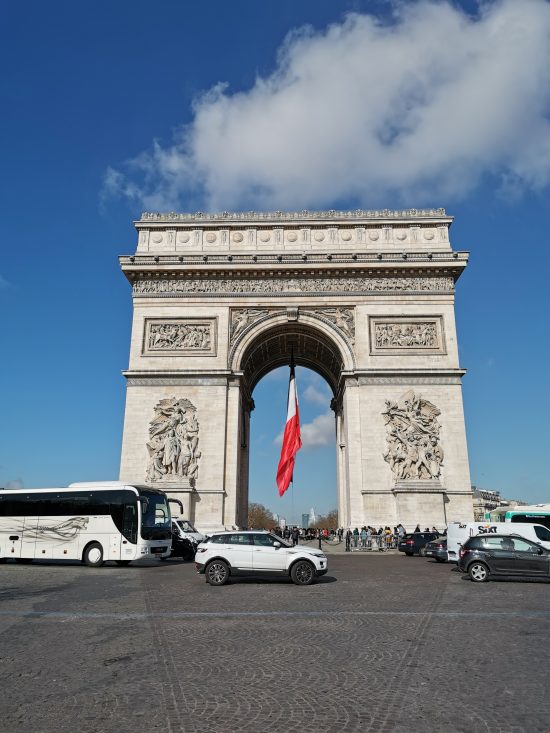
Huawei P30 Pro, outdoor item and noise

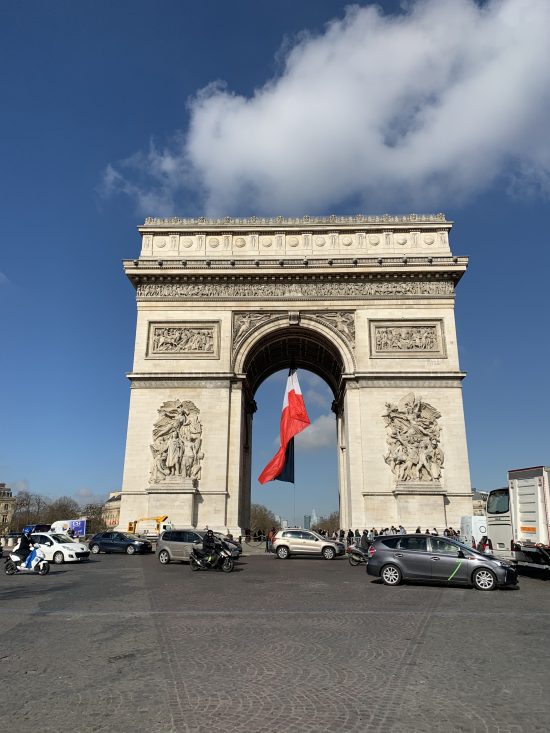
Apple iPhone XS Max, outdoor detail and noise

Apple tree iPhone XS Max, crop
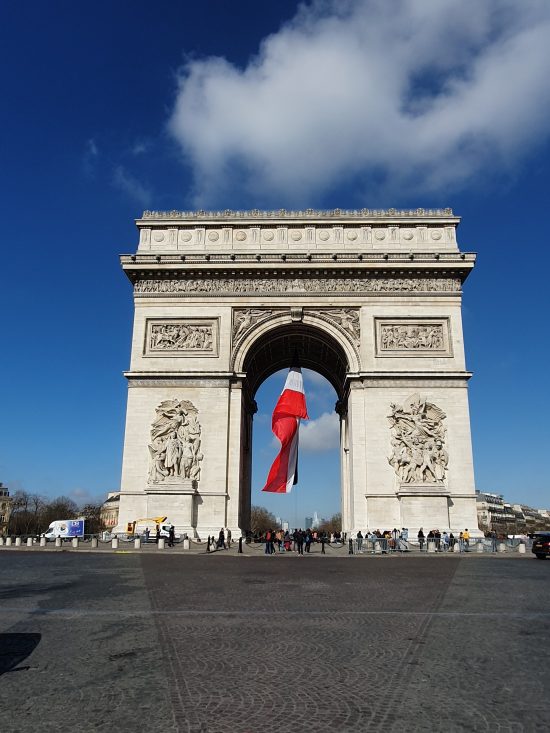
Samsung Galaxy S10+, outdoor detail and noise

Samsung Galaxy S10+, crop
The situation is very similar for indoor conditions. The sample below was shot in a dimly-lit bar, and the Huawei once more renders fine particular the all-time in our comparison. Detail in the iPhone XS Max image is not much worse, simply the Apple tree device produces noticeably more noise. The Samsung takes the opposite approach to Apple and captures a very clean paradigm, simply particular is noticeably blurred. In the illuminated area in the dorsum of the bar, however, you can run across the effects of the Huawei'due south slightly limited dynamic range, with some noticeable clipping and hue-shift artifacts around the clipped areas.
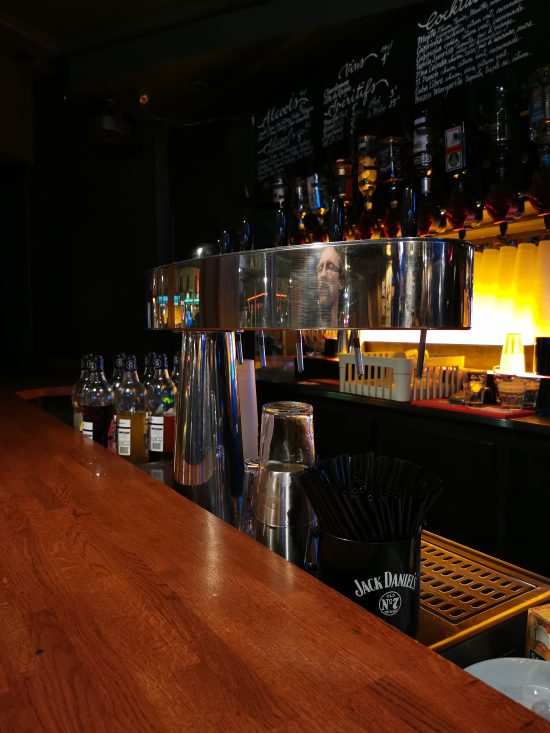
Huawei P30 Pro, indoor detail and noise


Apple iPhone XS Max, indoor detail and noise

Apple tree iPhone XS Max, crop
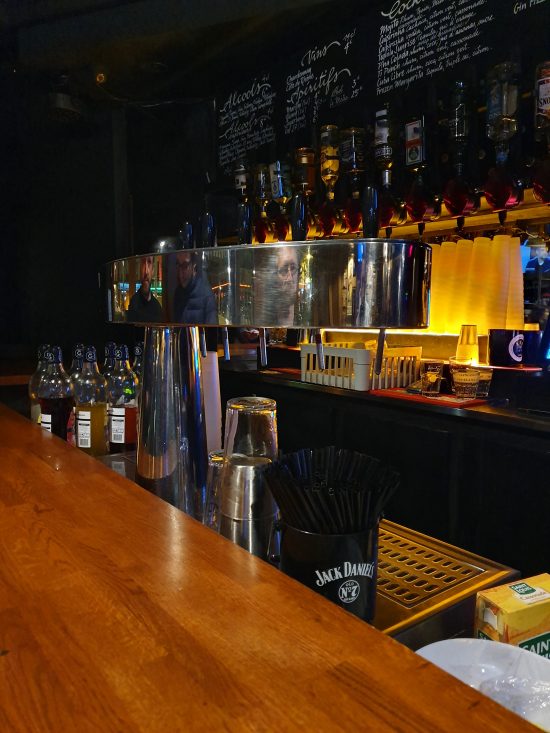
Samsung Galaxy S10+, indoor detail and noise

Samsung Galaxy S10+, crop
The P30 Pro's default camera mode manages to record decent detail even in night shots. Looking at the cropped expanse, it is obvious that it smooths away some low-dissimilarity detail via noise reduction, but considering the light conditions, the results are withal pretty impressive and clearly ameliorate than those of the XS Max and the Samsung. An unusual red artifact can be seen on the illumination of the bodily belfry itself, however (we'll take a closer expect at that in the Artifacts department further below).
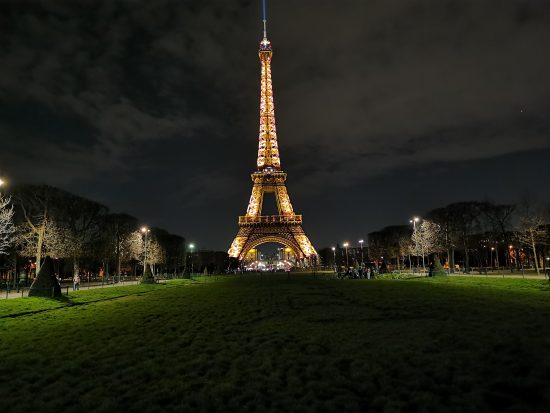
Huawei P30 Pro, low-lite detail and dissonance

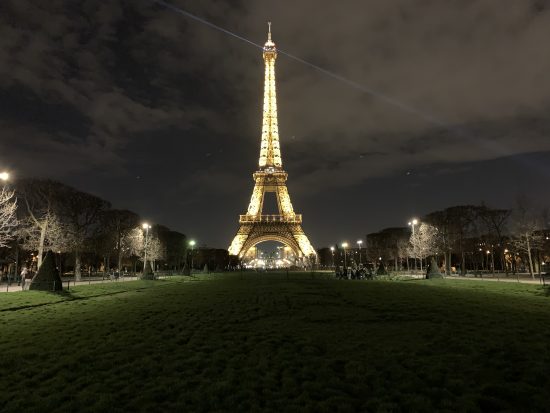
Apple iPhone XS Max, low-light detail and noise

Apple iPhone XS Max, crop
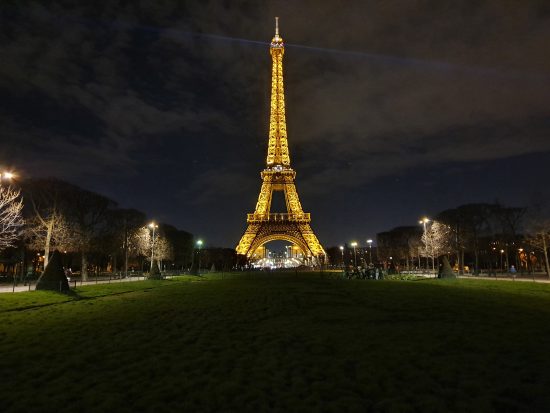
Samsung Galaxy S10+, depression-light item, 20 lux

Samsung Galaxy S10+, crop
The texture comparison chart below, which is based on the results of our lab testing, confirms what we've already seen in the sample above: the Huawei P30 Pro records higher levels of detail than its closest competitors across pretty much every lite status.
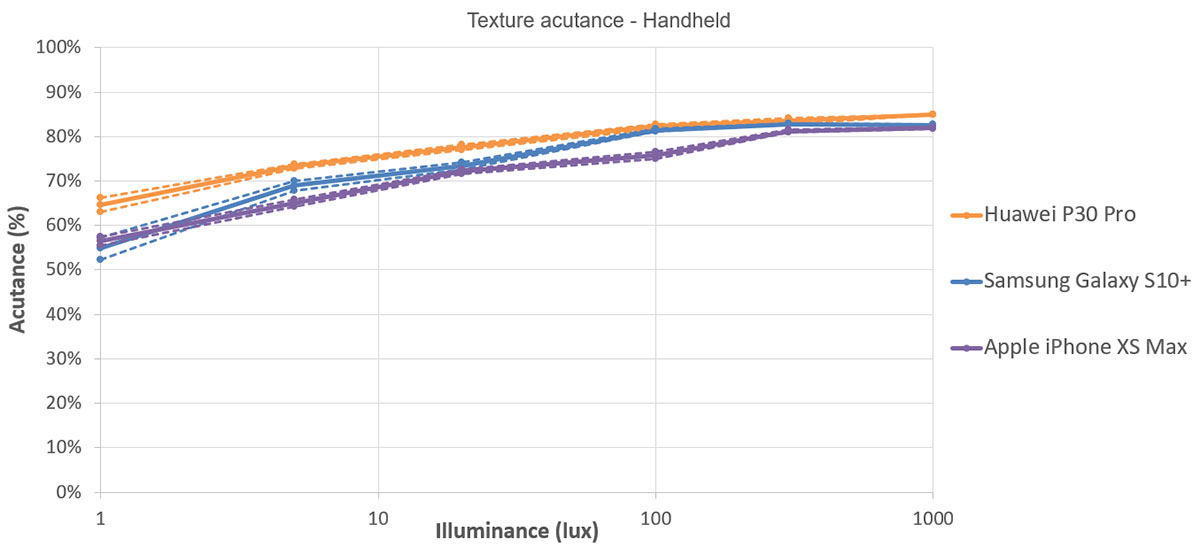
Texture acutance comparison

Artifacts
When examining the P30 Pro'south sample images, our testers establish some ringing forth high-contrast edges and a slight loss of sharpness in the corners of the frame. However, the well-nigh intrusive image artifact by far for the Huawei is a hue shift that tin be found shut to clipped areas in the frame. In the epitome below, y'all can run into it in the shape of the yellow colour around the neon sign on the storefront in the background. In many outdoor images, you can see the aforementioned phenomenon in blue skies that turn noticeably cyan before clipping to white.
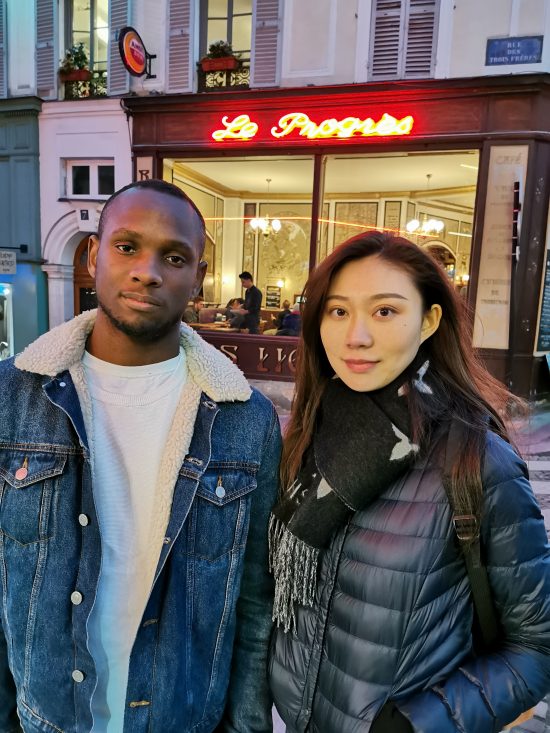
Huawei P30 Pro, hue shift

You lot can meet another unusual artifact in this night shot of the Eiffel Tower. The pinkish/ruby artifacts on the illuminated tower have some similarity to chromatic aberrations, simply are possibly caused by the sensor's demosaicing.

Huawei P30 Pro, demosaicing artifacts

The P30 Pro achieves an excellent score for Flash, thanks to images that show fairly good exposure, accurate white balance, good detail, and well-controlled noise levels. This is true for our examination shots at both 0 and 5 lux illumination. Some slight colour shading is visible in both situations, but the results are very consequent and the Huawei performs very well overall when shooting with its LED flash.

Huawei P30 Pro, wink at 0 lux


Huawei P30 Pro, flash at 5 lux


Zoom
Thanks to its innovative 5x tele-lens with folded optics and super-resolution engineering science, the P30 Pro achieves far and away the best zoom results we accept seen on a smartphone photographic camera to date. In the samples below, you can see that the Huawei captures much better detail than its closest competitors when zooming. In addition, the P30 Pro controls racket very well, producing non only the most detailed just also cleanest image in our comparison.



Apple iPhone XS Max, 5x zoom

Apple tree iPhone XS Max, crop

Samsung Galaxy S10+, 5x zoom

Samsung Milky way S10+, crop
At 10x magnification, the photographic camera combines the optical lens with a super-resolution algorithm. Detail is reduced compared to shorter zoom ranges, merely the departure between it and the competition is withal very obvious.
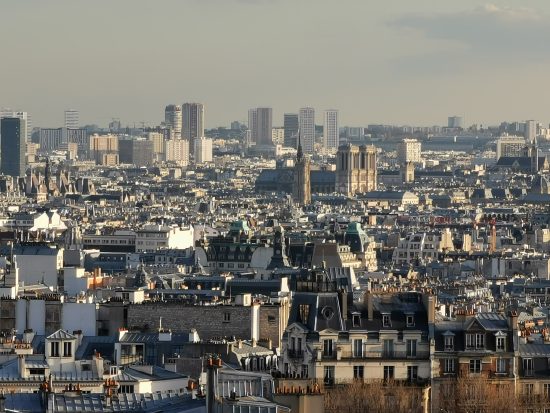

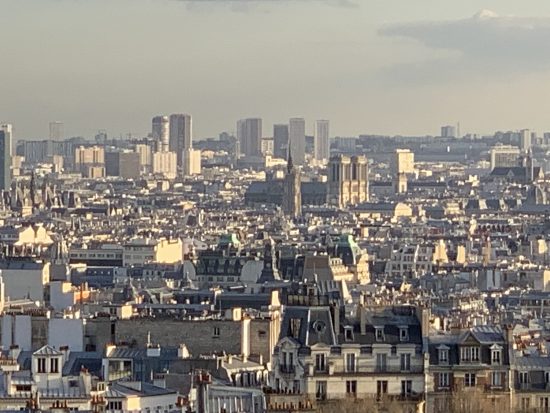
Apple iPhone XS Max, 10x zoom

Apple tree iPhone XS Max, crop
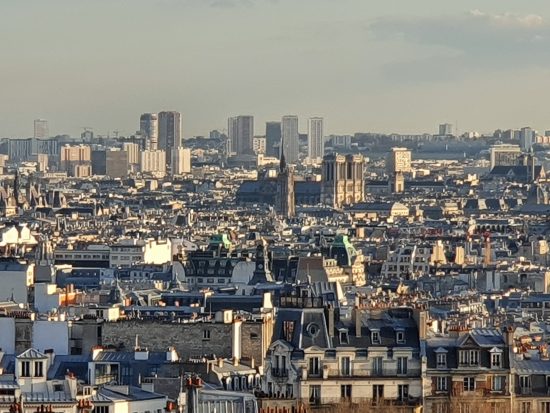
Samsung Galaxy S10+, 10x zoom

Samsung Galaxy S10+, crop
The P30 Pro as well performs very well in indoor light weather condition. The 2x sample below uses simply the primary camera and super-resolution, delivering epitome quality that is pretty much on par with the iPhone XS Max and the Galaxy S10+ at the same zoom factor. Different the Apple tree and the Samsung, however, the Huawei tin maintain splendid levels of particular at longer zoom ranges also. For the 3x image, the device uses Huawei's field-of-view fusion zoom that we explained in the introduction. The 5x image only uses the tele-photographic camera. On the downside, you sometimes get a slightly different color rendering with the tele-camera than with the main camera; in the samples beneath, for instance, you tin see that the 5x image is noticeably more yellow than the other ii.
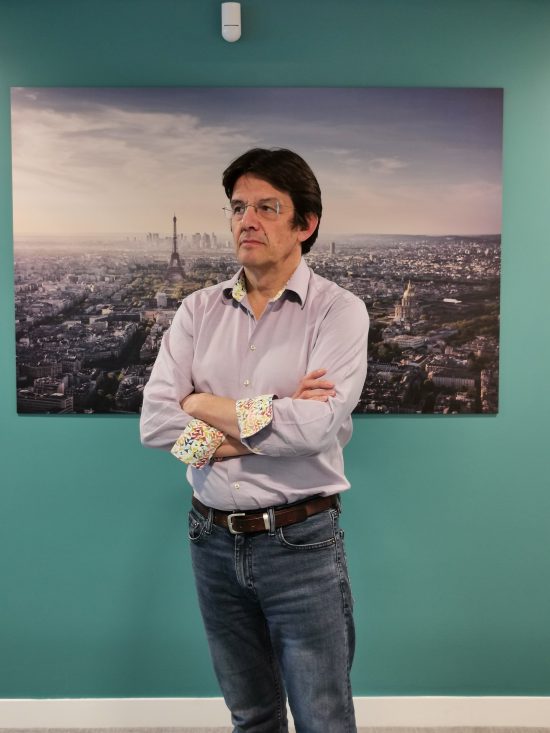
Huawei P30 Pro, 2x zoom indoors


Huawei P30 Pro, 3x zoom indoors


Huawei P30 Pro, 5x indoors

Another betoken of criticism is the tele-camera'south autofocus system, which is much slower than on the main camera. With the tele-cam engaged, the AF can take between one and two seconds to lock on. It'south also worth keeping in mind that the tele-cam has a minimum focus distance of approximately one.7m. You tin notwithstanding switch to a 5x zoom if you get closer, but the tele-cam will not engage; instead, the main camera will capture the image using digital zoom.
This phenomenon is visible in the close-upwards portrait beneath that was captured indoors at a subject distance shorter than 1.7m. The tele-camera did non engage, and as a issue, the Mate twenty Pro and the Xiaomi Mi nine capture slightly ameliorate levels of detail using their 3x and 2x tele-cameras, respectively, than the new Huawei in this specific situation.

Huawei P30 Pro, 5x zoom close-up

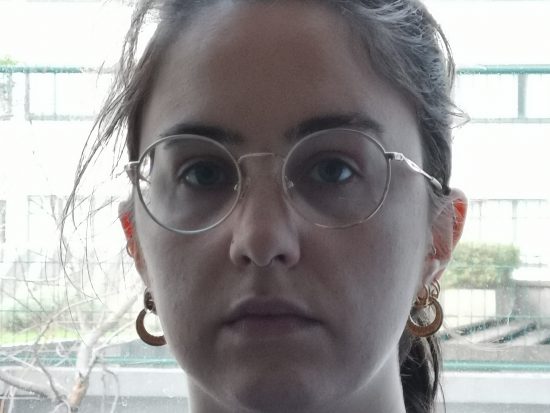
Huawei Mate 20 Pro, 5x zoom close-up


Xiaomi Mi nine, 5x zoom shut-upwards

It's also worth keeping in mind that the new field-of-view fusion zoom comes with a side consequence. The epitome below was captured at a 4x zoom factor. At this setting, the camera captures an image with the 5x optical tele-cam and fills in the "missing" image areas around the edges using AI-enhanced image data from the master camera. If you expect closely, you'll see that paradigm item drops noticeably close to the edge of the frame when compared to the center. It'southward not a major business concern, simply important to know if yous plan on making large prints or displaying images at full size.

Huawei P30 Pro, 4x zoom, detail at the center of the frame


Huawei P30 Pro, 4x zoom, item at the border of the frame


Bokeh
Like its zoom, the P30 Pro'south bokeh mode is the currently best you can find on a smartphone, cheers to the camera's ToF sensor and super-resolution applied science. The latter helps attain a 2x magnification, which is better suited to portraiture than the chief camera's broad angle, without a loss of item. The ToF sensor helps generate a more detailed depth map, resulting in very good subject isolation.
In the comparing below, you can see that subject field item in the P30 Pro image is better than in the iPhone XS Max epitome (shot with its 2x optical zoom). The Huawei too offers a better blur rendering: unlike the iPhone, information technology does not blur any part of the subject'due south body; the blur gets more than intense towards the back of the scene; and spotlights are rendered nice and abrupt. The Samsung captures its bokeh style images without applying any zoom, resulting in a perspective that is traditionally viewed as less desirable for portraiture.
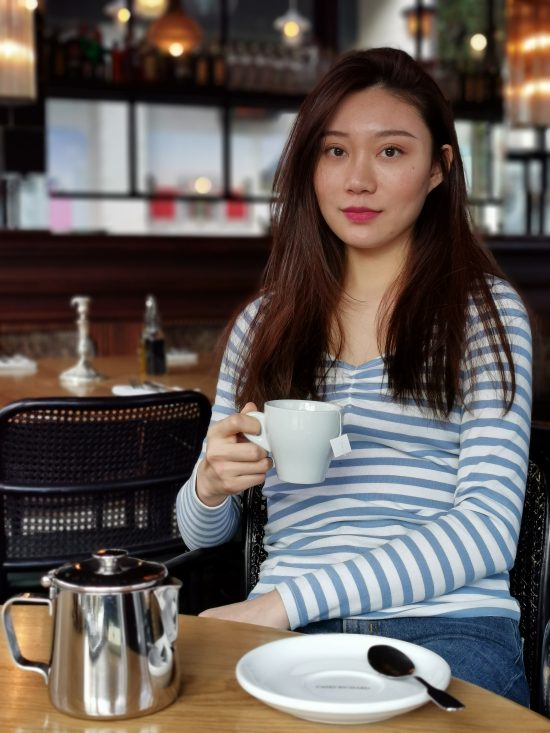
Huawei P30 Pro, bokeh style

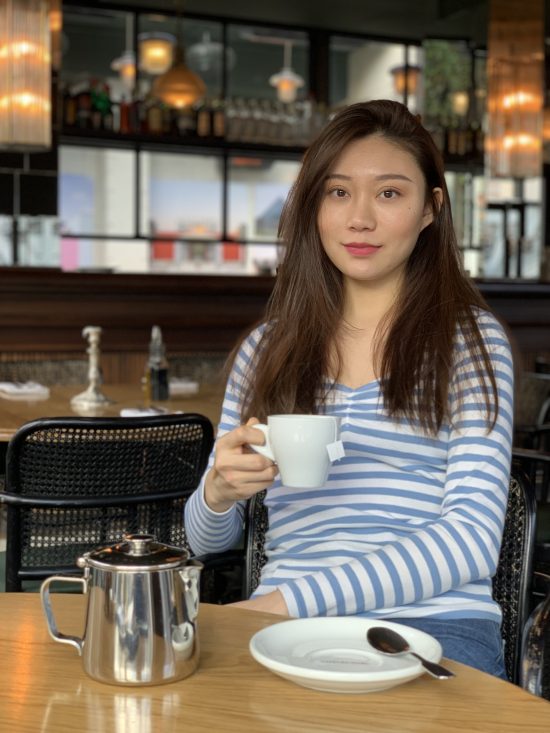
Apple tree iPhone XS Max, bokeh mode

Apple iPhone XS Max, crop
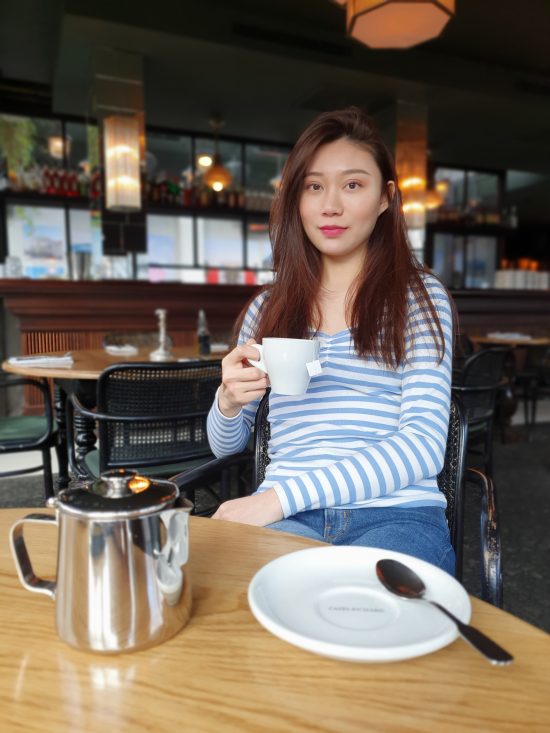
Samsung Galaxy S10+, bokeh manner

Samsung Galaxy S10+, crop
The P30 Pro's bokeh fashion also blurs nicely objects in the foreground, such every bit the establish on the desk in the sample scene below. In this comparison, the new smartphone delivers the all-time detail on the face and deals best with such circuitous scene elements as the subject area's earring.

Huawei P30 Pro, bokeh mode


Huawei Mate twenty Pro, bokeh mode



Video scores explained
At 97 points, the Huawei P30 Pro achieves a good score for Video, making the device a great all-around mobile imaging option. The overall video score is derived from a number of sub-scores in the same way as the Photo score: Exposure (85), Color (86), Autofocus (98), Texture (58), Noise (77), Artifacts (85), and Stabilization (94).
The P30 Pro camera produces generally skillful target exposure when shooting video. Every bit with its stills fashion, the camera is capable of exposing video scenes well down to impressively low lite levels. On the downside, our testers observed local tone mapping instabilities in virtually videos, with the brightness of some paradigm areas irresolute for no obvious reason.

Huawei P30 Pro, video exposure
Video color characteristics are very like to photos likewise, with slight white balance casts when recording outdoors in bright light or nether typical indoor lighting. Our testers also observed some white balance instabilities and stepping when the system is adapting to a change in illumination. The autofocus works just as well in video manner as information technology does when taking photos—it is accurate and quick to react to changes in the scene. Subject tracking is also very good.
In default mode, the Huawei records footage at 1080p resolution. A loss of detail is noticeable in low low-cal, but the camera maintains skilful rendering of textures and image details when recording video in bright light and nether typical indoor conditions. Some noise is visible fifty-fifty in bright light, but it is better controlled at medium light levels. In low light, noise levels increase once again and go quite intrusive.
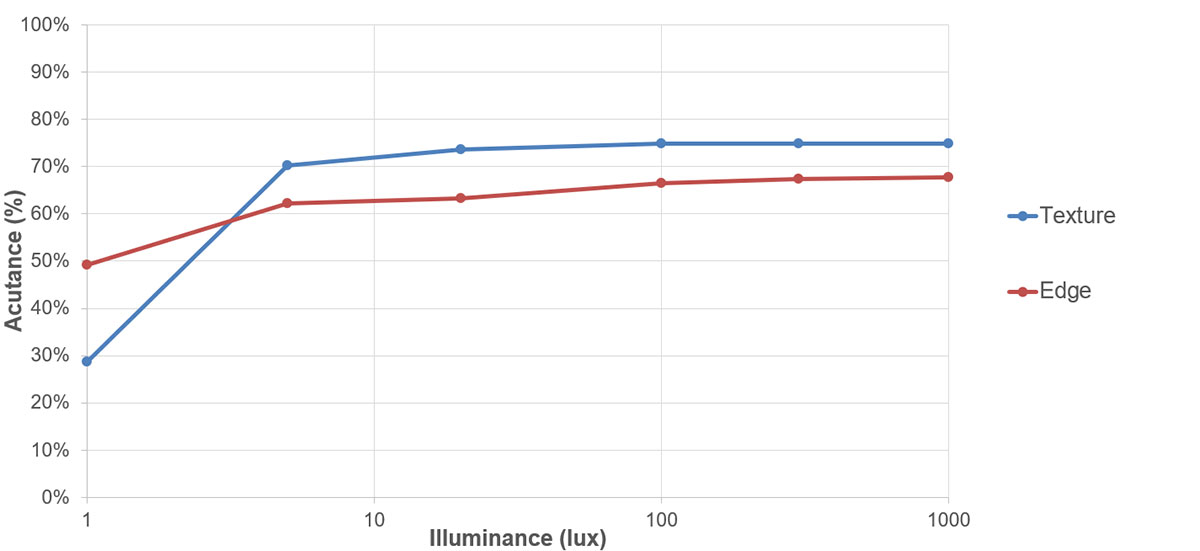
Huawei P30 Pro, video texture and border acutance
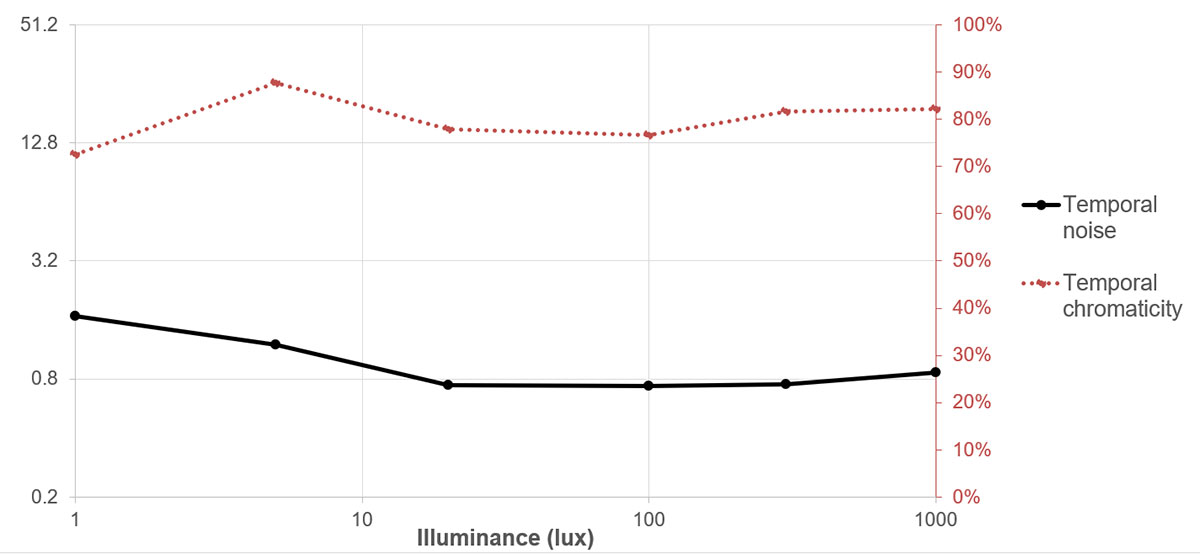
Huawei P30 Pro, video noise
Artifacts are more often than not well under control in video style, simply our testers institute some ringing in the footage. Ringing is besides often visible when the camera changes the frame rate from 30 to 60fps or vice versa, peculiarly when panning. (The device uses the congenital-in gyro to measure move and increases the frame rate to ensure good sharpness of the footage.)
Video prototype stabilization on the P30 Pro is one of the best we have seen, thanks to an efficient combination of optical and electronic epitome stabilization. The system works very well both when shooting while holding the photographic camera even so and when recording while walking.
Huawei P30 Pro, outdoor video panning
Huawei P30 Pro, outdoor video walking
Determination: Huawei takes smartphone zoom to the next level
If you nevertheless needed a reason to spend money on a compact camera, it would accept been for zoom reach, as even the best smartphone cameras could non provide usable zoom prototype quality across a 5x gene. This has now changed with the Huawei P30 Pro and its innovative zoom system that uses folded eyes and a super-resolution algorithm, which finally makes usable 10x zoom on smartphones a reality.
The zoom on its own will make the new Huawei an extremely tempting option for many mobile photographers, but the camera performs very well in nearly all other areas as well. The bokeh mode is the best we accept seen; paradigm detail and noise levels are excellent beyond all low-cal levels; and the camera records high-quality footage in video mode. In that location is however some room for improvement in terms of color and artifacts, only these are relatively minor shortcomings that nigh users will be able to easily live with.
Add the super-wide-angle camera (which as with other devices with a similar camera setup, did not accept an impact on Huawei's DxOMark score) into the mix, and the P30 Pro is easily the virtually versatile mobile imaging tool to date, allowing you to cover a wider range of photographic situations than any other smartphone.
Photo pros
- Expert detail and long zoom range
- Skillful target exposure even in very low light
- Fast and accurate autofocus
- Good detail in low calorie-free
- Very adept prototype results when shooting with flash
- Accurate depth estimation and skilful item in bokeh mode
Video pros
- Very proficient stabilization
- AF reacts rapidly to scene changes, good tracking
- Low dissonance levels and decent detail in bright calorie-free and indoors
- Generally expert target exposure
- Accurate white rest and good color rendering
Photograph cons
- Unnatural rendering of sky color when shooting outdoors
- Slightly limited dynamic range can issue in highlight clipping
- Range of image artifacts, including hue shift, ringing, and loss of acutance
- Soft corners in medium-range zoom images
Video cons
- Stiff dissonance in depression-lite videos
- Some exposure and white residual instabilities
- Sharpness varies between frames in indoor videos
- Frame rate changes noticeable in panning videos
In the Press
Source: https://www.dxomark.com/huawei-p30-pro-camera-review/
Posted by: petersonsamelver1993.blogspot.com



0 Response to "Huawei P30 Und P30 Pro Test"
Post a Comment